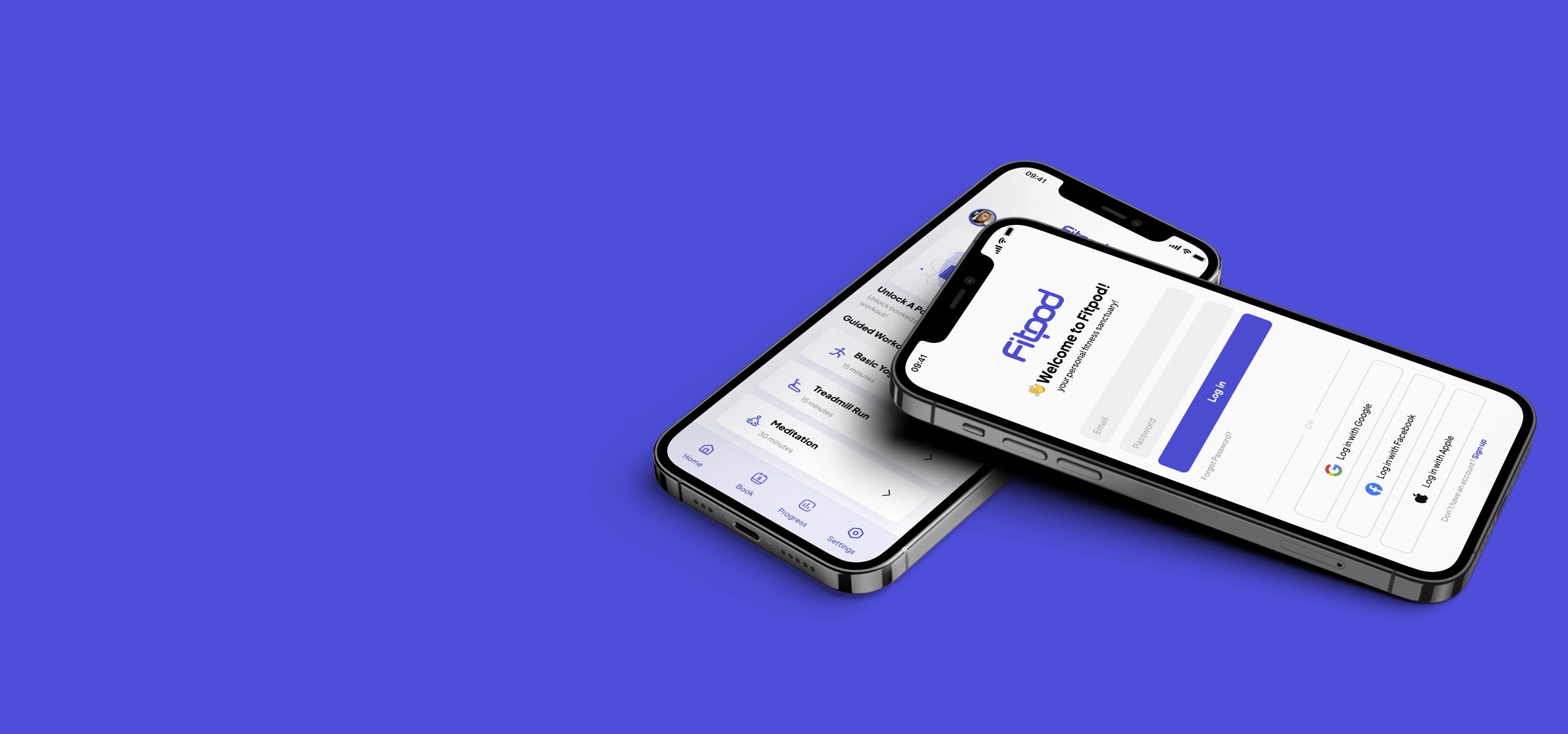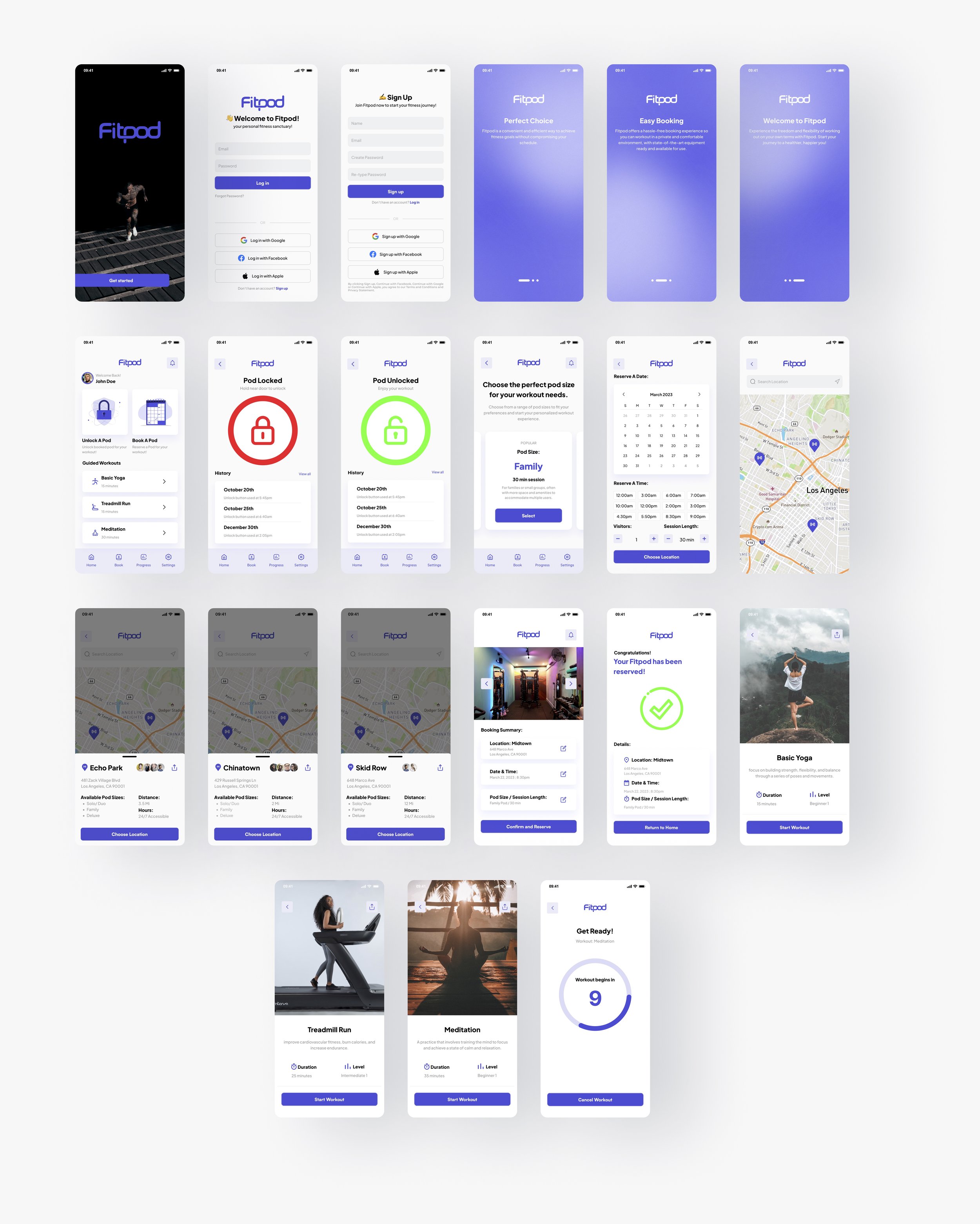
PROJECT OVERVIEW
Fitpod is an app that provides a unique and convenient fitness experience with personal gym pods equipped with top-of-the-line equipment. Our mission is to make fitness accessible and enjoyable for everyone, with flexible scheduling and affordable pricing. Our personal gym pods provide the perfect solution for those looking to get fit and stay healthy without the hassle of crowded gyms or strict schedules.
ROLE
UX Researcher
UI Designer
TOOLS
Figma
Adobe Creative Suite
Google Forms
Miro
Zoom
DURATION
3 months
TARGET MARKET
Fitpod is targeted at users who are interested in fitness and prefer the convenience and privacy of booking and using a private gym pod. They may have limited time or space, seek personalized and customizable workout experiences, and want to avoid distractions during their workouts.
Challenges:
❌ Users experience limited time for gym visits due to busy work schedules or other obligations.
❌ Concerned about crowded gym spaces and waiting for equipment.
❌ Traveling frequently and needing access to gym facilities on-the-go.
❌ The desire for a more private and personalized workout experience.
GOALS:
✅ Provide users with the convenience of booking and using a Fitpod at any time that suits their schedule, without having to worry about gym hours.
✅ Provide a private and comfortable environment to exercise in without the distraction of other people around.
✅ Offer a safer workout environment with limited exposure to others, reducing the risk of spreading illnesses.
PROBLEM STATEMENT:
“With busy lifestyles and limited time, people find it difficult to maintain a consistent workout routine. Traditional gyms may not be convenient, and privacy during workouts may be compromised.”
DESIGN PROCESS:
ASSUMPTION MAP
To begin research, an assumption map was created to identify and evaluate assumptions about Fitpod's target market's preferences, behaviors, and motivations. This helped to gain a better understanding of their needs and wants and adjust product or marketing strategies accordingly. This also helped make the application effective and successful with meeting the needs of users.
MY ASSUMPTIONS:
Users are interested in using private gym pods as a convenient and efficient way to exercise.
Users are willing to pay a premium for the convenience and privacy offered by private gym pods.
Users are tech savy therefore comfortable using a mobile app to book and manage their workouts.
KEY FINDINGS:
Users are looking for a gym that is accessible and easily located near their home or workplace.
Over crowded pods will create same problem as other gyms (full and busy), so creating different pod sizes would be helpful for booking.
Users are looking for a gym that provides access to the latest fitness equipment and technology.
COMPETITIVE ANALYSIS
Conducting a competitive analysis was essential to gain insight into the strengths and weaknesses of similar private gym pod booking apps on the market. By analyzing competitors' features, pricing, marketing strategies, and customer reviews, I was able to identify gaps in the market and areas where I could differentiate the app. Additionally, the analysis helped identify best practices and areas for improvement, which can inform product development and marketing strategies.
USER SURVEYS
Completing user surveys helped me discover Fitpod's target market's preferences, needs, and behaviors. The survey was 10 questions long and included topics such as willingness to pay for a gym pod booking app, features they would like to see in such an app, frustration with the gym, and more. I surveyed a total of 25 users, and after analyzing the survey results, I gained a deeper understanding of the target market and identified areas where the app could meet their specific needs and preferences.
USER PERSONAS
User personas were created based on the competitive analysis and user survey to better understand the target market's characteristics, preferences, and goals. By creating these user personas I was able to empathize with my users and design Fitpod to meet their specific needs, resulting in a more effective user experience to attract and retain customers.
USER TASK FLOW
Creating a task flow was a pivotal moment in designing an intuitive and seamless user experience for Fitpod's target market. The task flow accounts for user goals, preferences, and pain points, creating a seamless and enjoyable user experience. This blueprint will also aid future design and development decisions, ensuring the app remains user-centered throughout its development.
SKETCHES/LO FIDELITY SCREENS
Sketching the user flow was an important step in bringing the flow to life before designing the lo-fi mockups in Figma. Helping me create wireframes that were more detailed and refined while still maintaining a low level of fidelity. This allowed me to test the layout, structure, and functionality of the Fitpod app before investing too much time and resources into the high-fidelity design. Figma helped streamline the design process and reduce the likelihood of major design changes during the development phase.
STYLE GUIDE
My goal while designing the style guide was to create a consistent and cohesive look across all screens to create a visually appealing and memorable user experience. The typography was chosen based on readability and legibility; the iconography was chosen to create a visual language that is intuitive and easy to understand, with the layout designed to ensure a seamless experience. By creating the style guide this way, I was confident that the app would be visually engaging and memorable, attracting and retaining long-term users.
USABILITY TESTING
Usability testing was conducted to ensure that the design of the app was practical and effective in meeting the needs and preferences of the users. This included asking users to perform specific tasks within the app and offering suggestions and notes to help the user experience. With this testing completed, the design was fine-tuned to make Fitpod both beautiful and functional.
FINAL UI SCREENS
With the style guide and usability tests completed, I was able to apply everything to the final interface of the app. By applying the style guide to the final interface, I was able to create a stunning and cohesive design that users would love. It was exciting to see everything come together and watch the app take shape, knowing that it would soon be in the hands of users, helping them to achieve their fitness goals in a more personalized and convenient way.

FINAL THOUGHTS
This project was a lot of work, but it was rewarding to watch Fitpod come to life. Conducting user research, competitive analysis, and creating user personas helped to ensure Fitpod met the needs of its users. Consistency was key to creating a cohesive and visually appealing user experience, so creating a style guide and applying it throughout the app helped to achieve that goal. Overall, the project was successful and Fitpod will be a rewarding experience for users trying to reach their fitness goals.












